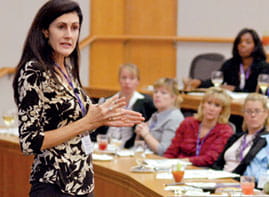Great global brands demand clarity and distinction — and a strategic framework to capture customer value, Kellogg experts say
9/2/2009 - (Continued from
page one)
Post-war branding: ‘new whys for buys’
One of those blazing the trail for this richer brand understanding was Sidney J. Levy, the Kellogg School’s Charles H. Kellstadt Professor Emeritus of Marketing. In his seminal 1959 article “Symbols for Sale,” Levy explained how, for many modern consumers, shopping had become more than just a means to satisfy material needs. In the U.S. after World War II, for example, those enjoying the commercial boom brought about by pent-up demand and the return of wartime manufacturing plants to civilian duty were focusing less on buying to address traditional concerns, like physical survival, and more on expressing themselves. Buying behavior became more abstract and symbolic, according to Levy.
If during austere times “economic man” had seen price as the overriding factor, the consumer now was receptive to other considerations too. Increasingly brand conscious, these people encountered an “astonishing variety of merchandise, all of it displayed in equally astonishing ways,” Levy wrote. In this new setting, people often shopped “lavishly,” he observed, paying attention to how a purchase could satisfy “many aims, feelings, wishes, and circumstances.” Levy quipped that there were “new whys for buys” that included the influence of many marketing elements — from packaging color to advertising channels.
Yet, for marketers to gain access to underlying consumer motivations meant moving beyond the “gross assumptions” “quick generalizations” and “overly simple and nonoperational” ideas about human psychology, Levy wrote in another influential article, “The Product and the Brand” (1959). Brand was not just a manufacturer’s mark or label, he said, but “a complex symbol that represents a variety of ideas and attributes.” This new reality required a complete “rethinking of brand advertising,” as well as a new way of researching consumer insights. By melding quantitative and qualitative approaches and using smaller samples and more conversational interviews, for example, marketers could uncover latent consumer attitudes about a brand and a person’s relationship with it.
From the mythic to the modern
As early as 1908, Northwestern University business school faculty, including Walter Dill Scott, had explored advertising with the tools offered by the then-new field of psychology. By 1922, Fred Emerson Clark in
Principles of Marketing was also outlining the dynamics of branding.
Despite these and other early advances, marketing remained an underdeveloped “functional” pursuit for half a century. Its importance emerged as thought leaders such as Levy and Philip Kotler began rewriting the rules of their discipline, including with their co-authored landmark publication “Broadening the Concept of Marketing” (1969), which posited that “everyone markets,” not just corporations. Marketing principles could help nonprofit and public organizations as much as for-profit entities. By approaching marketing with economic and psychological tools, they helped transform what had been a descriptive field into one that held enterprise-wide strategic implications.
Kotler, the S.C. Johnson and Son Distinguished Professor of International Marketing, has remained a global authority on marketing, contending that “brands provide the major defense against price competition” because they can create a sense of trust and superior quality in consumer’s minds. But to do so, brands must offer more than just a compelling image. “The key is to develop a distinctive offering, not simply a distinctive image,” Kotler says. (Although, adds Levy, a sharp image may prove formidable when the offering is
not particularly distinctive, and the product, service or idea is basically the same as the competition’s.)
Even once a brand captures the customer’s attention, says Dipak Jain, the hard work of retaining that customer and cultivating a long-term relationship requires continual effort, since strong initial connections can dissipate if managed poorly.
One key to providing a superior value proposition, he says, lies in developing customer intimacy and harnessing the insights that will help enable a firm to create offerings that provide solutions to those needs.
Customer is (still) king
 |
| Mohanbir Sawhney |
To succeed in this effort means putting the customer first — including during economic downturns when there may be fewer new customers, according to Mohanbir Sawhney, the McCormick Tribune Professor of Technology. Retaining customers during a gloomy market is paramount, he says, in part due to the high costs associated with attracting new ones. He estimates that it can be up to five times as costly to attract a new customer as it is to retain an existing one.
Sawhney says customer-centricity has three components. “Step one is developing a better understanding of customer needs by getting close to customers and engaging them in product development,” he explains. “The next step is using that insight to create superior products, service and value propositions, which involves segmentation and value proposition development. Step three is delivering on a customer experience that’s better than the competition.”
Indeed, deep customer insights are playing a larger role in product innovation and paving the way for organizational transformation.
This approach to customer engagement is very important, agrees Davis. In
The Shift, he traces what he calls the three eras of marketing. He describes how “the golden age of advertising” focused on controlling the message, communicating to customers without much intimacy or feedback from them. The second era, he says, is where marketers figured out how to have a two-way conversation. Today, Davis believes this discussion has expanded in the networked era. “The dialogue is going on all around us,” he says. “Marketers today need to be more equipped to manage and actually be the driver in this networked era.”
Davis calls for marketers to transform themselves from “tacticians” to “visionaries” who have a seat in the CEO suite. While a company’s culture plays an important part in whether a chief marketing officer can become an influential senior executive, Davis cites numerous examples of leaders who have “gotten” the marketing message and made brand strategy an integral part of their organizations.
“I believe the days of marketing as a function are over,” Davis says. “The days of marketing as a pervasive asset throughout the entire organization have to become the new reality. Stop talking about marketing budgets and investments in isolation from growth budgets and growth investments.”
Like Sawhney, Davis sees brand-building and customer intimacy as key.
“Your brand and your business will be managed and controlled with or without you,” Davis says. Today, “because of commoditization and the proliferation of avenues to build brands and get your message across, you really have lost control of building your brand on your own. You can no longer push your brand message; you need to engage in a different type of dialogue [with customers].”
Marketers must move “from communication to participation and engagement with customers,” he says, “from being closed to being open, transparent and authentic.”
Getting the ‘global’ mix right
The same technological forces that Davis sees driving customer engagement also have helped propel global brands, says Betsy Holden. Global media and communication vehicles have facilitated brand extensions into new markets. “Customers are growing increasingly aware of global brands,” she says, “and the infrastructure for reaching them is improving.”
 |
| Betsy Holden '82 |
Because of this, Holden says that brands with superior quality and positioning offer companies a more efficient way to enter a new international market than might otherwise be the case if the firm had to create a brand from scratch for the purpose. A company can find more opportunities to leverage its scale, expertise and core competencies, resulting in significant potential cost savings.
Not all brands have equal global potential, though, says Holden. Food products can present tougher global challenges “because of their link to local customs and rituals.” During her Kraft tenure, Holden recalls, the company discovered that some categories, like beverages and snacks, “traveled more easily than meal products.” She says that understanding the migration paths for different products is a great source for innovation. For instance, a lot of beverage brands start in Asia, she says, while snack foods often start in the United States.
Obtaining these insights requires connection with customers and on-the-ground intelligence, Holden says. The company should ask some serious questions before entering a new country: What is a category’s attractiveness? How competitively concentrated is it? How likely is the firm to gain the No. 1 or 2 market share? How profitable is the category? Other important considerations include assessing the company’s management capability, technology, assets and sales and distribution channels.
Then, another challenge awaits: determining how to put those insights into action. Holden says that global companies sometimes struggle with figuring out the right balance between local and central control of their brands.
“What you deliver needs to have central guidelines so that it is consistent in quality,” she says. “But you also need to adapt to local needs and preferences.”
For example, Holden says that promotions need to be framed locally so that the offering can be adapted optimally with the local culture. “The questions to ask when developing integrated local promotions is ‘How do I adapt this to fit in and tie in with local events?’ The whole route to market has to be local. A developing market, for example, where you are selling in kiosks in Russia, is a different thing than when you are selling in U.S. supermarkets.”
Calkins agrees. “What works in one country may well not work in the next, and a program that builds sales in one place may actually cause a sales decline in another place,” he says. Unless the brand has consistency, customers may get confused. But because of different market conditions internationally a brand may require different marketing plans in each country, he says. “The way to ensure that a global brand feels like the same brand all around the world is to be certain that all the marketing plans are built on the same foundation,” Calkins says. “In every country, the positioning of a brand should be basically the same. The strategic initiatives may be different, and the tactics will almost always be different, but the feel of the brand will be the same.”
When it comes to an organization’s core innovation for global brands, though, Holden believes that the “innovation pipeline is often most efficiently coordinated and framed centrally.”
Whether organizations pursue a centralized or decentralized model for innovation management, global brands will continue to play an important role in driving the innovation agenda. Andrew Razeghi, lecturer of marketing, believes that the new innovation model will start with the brand essence, rather than with customer insights. Entirely new customer experiences, he says, will emerge based on the brand itself.
Razeghi, author of
The Riddle: Where Ideas Come From and How to Have Better Ones (2008), says that this approach “goes well beyond traditional brand extension strategies to brand-driven innovation.” Because of hyper-competition, communications saturation and value-oriented customers, he says “this emerging philosophy of brand-driven innovation will be the way forward for many companies as margins erode and competition heightens from nontraditional players.”
This approach, he adds, is as much an internal communications challenge as it is an external marketing communications challenge. “Brand managers need to re-brand themselves,” Razeghi advises. “They must begin to think of themselves as global brand innovators, not only participating in innovation, but driving it. And they must understand its potential on the global stage.”
The global Kellogg brand
The global approach has served the Kellogg School well during its own expansion, says Jain. By maintaining excellent quality control over the intellectual capital — faculty, curriculum, admissions requirements — Kellogg has been able to partner successfully with other top schools around the world to deliver a unique executive MBA education.
The school’s global alliances and partnerships began more than a quarter century ago, but have made especially great strides over the last 12 years, Jain says. Today, the Kellogg brand is known in Asia, Europe, the Middle East and North America. “We have worked closely with partners to ensure a proper fit between our curriculum and culture and the circumstances in those local markets,” Jain says.
Building what Jain calls “the global Kellogg culture” has meant ensuring that everyone enrolled in any Kellogg program anywhere in the world receives the same top-quality education, oriented around the school’s holistic “four pillars” leadership framework. Even more, he says this education must be delivered in the team-oriented environment that has become a Kellogg hallmark.
“One way we have created this global identity among our students is by offering them opportunities to interact with Kellogg peers across all programs,” Jain says, noting that all EMBA participants spend at least two weeks in Evanston during their education. These “Live-In” weeks provide an intensive academic and social experience that quickly imparts the essence of the Kellogg brand — academic excellence in a collaborative environment.
Jain says that early in his deanship, he sought to enhance the global Kellogg brand, building on the school’s entrepreneurial reputation and its pioneering advances in team-based learning. By expanding the curriculum to include more leadership courses and hands-on learning opportunities, Jain says that Kellogg has deepened its image as a thought leader.
He says the school’s alumni have been an important part of the school’s brand-building, too, which is why he launched a vigorous effort to engage the graduates.
“It was important to get our alums involved with the school, get them to be part of the initiative-driving process,” Jain says. “We learned how to offer our graduates ongoing value. This is what we mean by being customer-centric.”
The next step for Kellogg, and for management education overall, according to Jain, is to build on collaborative learning in a broader way. Through interdisciplinary efforts across the university, he says, business schools can tackle some of the most pressing social challenges — from poverty to pollution. Kellogg is already taking the lead in doing this, Jain says.
“We are in the business of producing global leaders who are successful and significant,” he says. “This is our brand promise. It’s a promise rooted in the power of innovation, inclusivity, and cutting-edge knowledge that’s put into action to make a positive impact in a world that needs transformative ideas.
“When people think of Kellogg, we want them to see an institution that is transcending expectations. The real proof of our brand, though, lives each day in the success of our global alumni network, which is making a difference for the world.”






